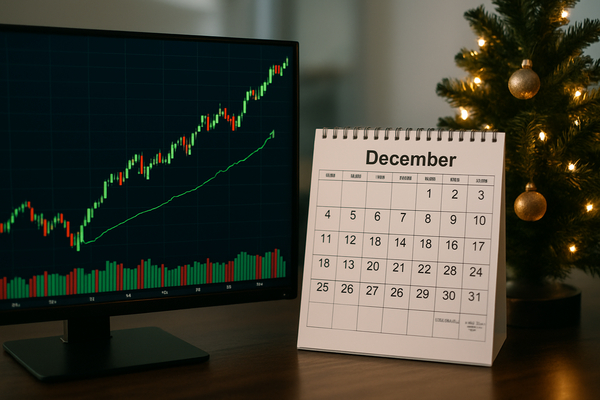
Wall Street rebound on renewed Fed cut bets sets the tone. U.S. stocks climbed after comments from Fed officials boosted expectations for a quarter point cut in December. This matters now because markets are pricing policy changes that could alter borrowing costs in the short term and corporate financing conditions over the long term. Globally, the move lifts risk appetite in the United States and Europe while leaving Japan on edge over a weak yen. Compared with last week’s selloff, the rebound shows how quickly sentiment can swing when central bank signals change.
Market snapshot and risk sentiment
Equities rallied strongly with the S&P 500 up about 1.6% and the Nasdaq higher by roughly 2.7%. Buyers returned to the largest technology names and large caps that had been under pressure after last week’s pullback. The Magnificent Seven group helped lead the move, restoring a portion of recent losses tied to valuation concerns and higher financing costs for rapid AI spending.
However this was not a simple rush into risk. Safe havens also saw demand. Gold advanced 1.4% and U.S. Treasuries firmed as yields fell. Crude oil rose about 1.3% as commodity markets reacted to the same mix of growth and policy signals. The dollar index slipped overall, even as the greenback strengthened against the yen after comments suggesting potential Japanese intervention in currency markets.
Fed comments and how markets priced a December cut
Comments from Fed Governor Christopher Waller and supportive remarks by New York Fed President John Williams shifted the balance of betting toward a December reduction in the federal funds rate. Waller said recent data point to labor conditions weak enough to support a quarter point cut on December 10. Rate futures now put the odds of a 25 basis point cut at roughly 67%, a notable increase from less than even odds last week.
That swing helps explain the equity rebound. Lower expected policy rates reduce discount rates on future corporate earnings and ease immediate financing pressures. Over the near term this encourages risk taking. Over the longer term, actual policy moves will matter for growth and credit conditions, with markets sensitive to follow through in labor and inflation data.
Economic calendar and calendar-driven volatility
Traders will be watching two delayed U.S. data releases that could reinforce or temper Fed expectations. The Producer Prices Index for September and retail sales for the same month are due to arrive after being postponed during the recent government shutdown. These reports will provide fresh signals on inflation and consumer spending just ahead of a holiday week that compresses liquidity.
Thanksgiving and Black Friday compress trading hours and create a thinner market environment. Early closes on Friday and firms making December book closings increase the potential for outsized swings. Retail sales and Black Friday crowds will offer an early read on consumer resilience as firms close books for the year. Given those timing factors, risk managers should expect larger intraday moves and quicker re-pricing around headline data.
Global flows, currencies and central bank sensitivities
The dollar eased against the euro while remaining firm against the Japanese yen. Comments from Takuji Aida, an adviser to Prime Minister Sanae Takaichi, signaled that Japan could step in if the yen weakened too far. That prospect keeps the yen volatile and traders alert to any official action that could disrupt carry trades and risk allocations across Asia.
Gold and Treasuries both gained, suggesting that investors are not yet confident in a pure risk-on environment. The coexistence of higher equity prices and stronger safe havens indicates mixed expectations about growth and policy. Energy markets showed modest strength with oil up about 1.3%, reflecting ongoing demand expectations even as macro uncertainty persists.
Analyst views, forecasts and market implications
Sentiment has been quick to flip since last week’s pullback. One notable projection from Deutsche Bank NYSE:DB that the S&P 500 could rise to 8,000 by the end of 2026 highlights how bullish scenarios coexist with caution in investor circles. That forecast is one view among many and helps explain why large caps have reclaimed ground as investors weigh longer term upside against nearer term policy risk.
For the coming session, markets will gauge whether the Fed rhetoric holds up under fresh data. A softer-than-expected PPI and resilient retail sales could create conflicting signals. If inflation pressures ease while consumers keep spending, markets may extend gains. If data surprises in the other direction, traders could quickly reprice rate cut odds and push volatility higher, especially with thinner holiday liquidity.
What traders should watch during the session
Focus will be on the PPI and retail sales prints and any follow up market commentary from Fed officials. Watch Treasuries for signs that lower yields are durable and monitor gold for continued safe-haven flows. Currency moves, especially yen volatility tied to potential Japanese intervention, may spill into equity performance for Asian exposures and multinational companies.
Finally keep an eye on Black Friday developments for a practical read on consumer spending trends. Early retail signals can influence year-end revenue expectations and feed into broader market positioning. With December book closings approaching, the interplay between data and positioning could produce sharp, short lived moves that set tone into year end.
Overall the session may start with momentum from Fed-driven optimism. But the compressed holiday calendar and key data releases mean that sentiment could reverse quickly. Investors will be balancing hopes for policy easing with fresh economic evidence and a backdrop of mixed global flows.












